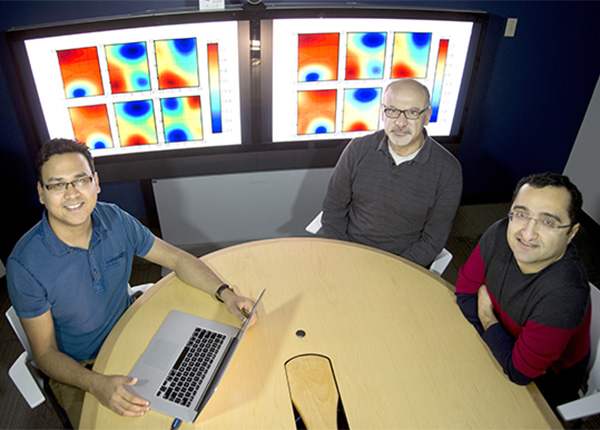Sandia researchers develop mathematical methods to improve computational efficiency in quantum chemistry
Sandia researchers have developed new mathematical techniques that can be used to study the behavior of large molecules at quantum scale. This technology helps reduce computation time and improves the predictive capability of theoretical chemistry models.

Sandia postdoctoral researcher Prashant Rai, working with Khachik Sargsyan and Habib Najm (all 8351) at the Combustion Research Facility (CRF), in collaboration with quantum chemists So Hirata and Matthew Hermes from the University of Illinois at Urbana-Champaign, developed computationally efficient methods to approximate potential energy surfaces of molecules by probing them at fewer configurations as compared to classical methods. Understanding potential energy surfaces, key elements in virtually all calculations in quantum dynamics, is required to accurately estimate the energy and frequency of vibrational modes of molecules.
The initial, promising results of this research will be published in Molecular Physics in an article titled “Low-rank canonical-tensor decomposition of potential energy surfaces: Application to grid-based diagrammatic vibrational Green’s function theory.”
“Approximating potential energy surfaces of bigger molecules is an extremely challenging task due to the exponential increase in information required to describe them with each additional atom in the system,” Prashant says. “In mathematics, it is termed the Curse of Dimensionality.”
Beating the curse
The key to beating the Curse of Dimensionality is to exploit the characteristics of the specific structure of the potential energy surfaces. Knowledge of this structure can then be used to approximate the requisite high dimensional functions.
“We make use of the fact that although potential energy surfaces can be high-dimensional, they can be well-approximated as a small sum of products of one-dimensional functions. This is known as the low rank structure where the rank of the potential energy surface is the number of terms in the sum,” Prashant says. “Such an assumption on structure is quite general and has also been used in similar problems in other fields. Mathematically, the intuition of low rank approximation techniques comes from multilinear algebra where the function is interpreted as a tensor and is decomposed using standard tensor decomposition techniques.”
Energy and frequency corrections to classical results are formulated as integrals of these high-dimensional functions. Approximation in such a low rank format renders these functions easily integrable as it breaks the integration problem to the sum of products of one or two dimensional integrals for which standard integration methods apply.
This method has been initially applied and tested on small molecules such as water and formaldehyde. When compared to the classical Monte Carlo method, a standard workhorse for high dimensional integration problems, this approach improves the computational efficiency by orders of magnitude with better accuracy at the same time. Rai said the next step in this study is to further enhance the technique by challenging it with bigger molecules such as benzene.
Interdisciplinary studies such as these provide opportunities for cross pollination of ideas, thereby providing a new perspective on problems and their possible solutions. In the context of combustion research at the CRF, this work advances the computational capabilities available for the detailed study of complex hydrocarbon molecules relevant in engine combustion.